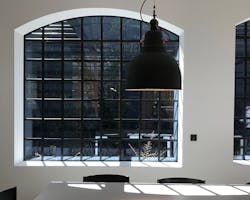Understanding Circadian Rhythm
The benefits of natural light have been studied for more than a decade, but the findings are now being utilized across the board in architecture and design—particularly in offices where artificially lit cubicles are on the way out.
In particular, studies have shown that natural light:
- Increases productivity
- Increases mood
- Creates healthier and better sleep
The reasons primarily have to do with one’s circadian rhythm.
Hospitality News ► The Graduate Hotels Bring Nostalgic Vibes
Circadian Rhythm Definition
Circadian rhythm is the body’s natural cycle throughout the day. Similar processes are found in most living things, and are affected by external factors, including light and temperature.
The color of natural light changes throughout the day due to the location of the sun in the sky and the density of the atmosphere. In the morning, sunlight is more blue while the sun’s evening hue contains more orange tones.
Recently, this has changed the ways in which technology appears. Studies found that the blue tone of the artificial light that comes from screens has a “wake-up” effect on the brain, leading to sleeping troubles for those who use any of the many screen-baring products that have come into the home in recent years. In response, many tablet and smartphone manufacturers added a feature that changes the tone to orange after a certain time to help the brain start to wind down at the end of the day.
Fantini Headquarters, Pella, Italy
In the last year, luxury bathroom fixture brand Fantini has opened a new hotel, redesigned its lakeside manufacturing facility and renovated its headquarters in Pella, Italy. Each building features an abundance of natural lighting, including massive floor-to-ceiling windows on the southeast side of the headquarters, and large-scale windows along the northwest wall.
With natural light and stunning views of Lake Orta, a common concern is that employees will spend more time daydreaming and staring out of the window than getting work done, but for Daniela Fantini, CEO, the productivity and increased mood in the office makes it worthwhile. In fact, any time spent staring out the windows has lead the team to more creative solutions.
The access to natural light isn’t only for those with creative jobs, however. The manufacturing facilities next door to the headquarters features plenty of natural light as well.
Oodi Library, Helsinki
Up north in Finland, natural light is as important a feature as any other when constructing a building. With the long, dark nights that the country is subjected to throughout much of the year, double-paned glass and skylights abound. Beginning with Alvar Aalto’s designs in the 1960s, it has become common for artificial light to be installed within the crevices of skylights to lessen the intensity of lighting change from day to night.
Helsinki’s Oodi Library is scheduled to open November 2018. Included in the monolith is a public space on the first floor that will host events and conventions, and an entire second floor designed to accommodate smaller groups in need of collaborative rooms or meeting spaces. The third floor will house the library stacks.
Glass is used throughout the building to allow natural light into the interior. On the second floor, many of the meeting rooms are constructed with glass walls so that light can penetrate even the most interior rooms.
The third floor is designed with nearly 360-degree views from the floor-to-ceiling glass curtain wall, and recessed skylights are built in every few feet. Even on dark days, the design allows as much natural light as possible for patrons.
TD Bank, Toronto
When TD Bank’s Toronto headquarters were being designed with international firm HOK, they came across a unique situation. Once most of the skyscraper’s floors were constructed, TD Bank officials decided to switch gears to allow the last floor to integrate WELL standards, including giving their employees access to natural light. Because the original floors weren’t built using WELL standards, the building could act as a case study on itself.
Natural light is among the core features of WELL, which also includes open workspaces with access to daylight and views, ambient lighting that supports circadian rhythm and shading to reduce solar glare.
The employees who utilize the meeting spaces on this WELL-focused floor report more productive sessions than those taking place elsewhere in the building.
More Design News ► Daily Updates | Joanna Gaines Enters Commercial Design | The Wing’s Is Fit for a Queen
About the Author

Kadie Yale
Former Editor-in-Chief
Kadie Yale holds a BA in Industrial Design from San Francisco State University and a MA in Decorative Art History and Theory from Parsons the New School. In her role as editor-in-chief from 2015-2018, she led the interiors+sources team in creating relevant content that touches on sustainability, universal design, science, and the role of design in society.
